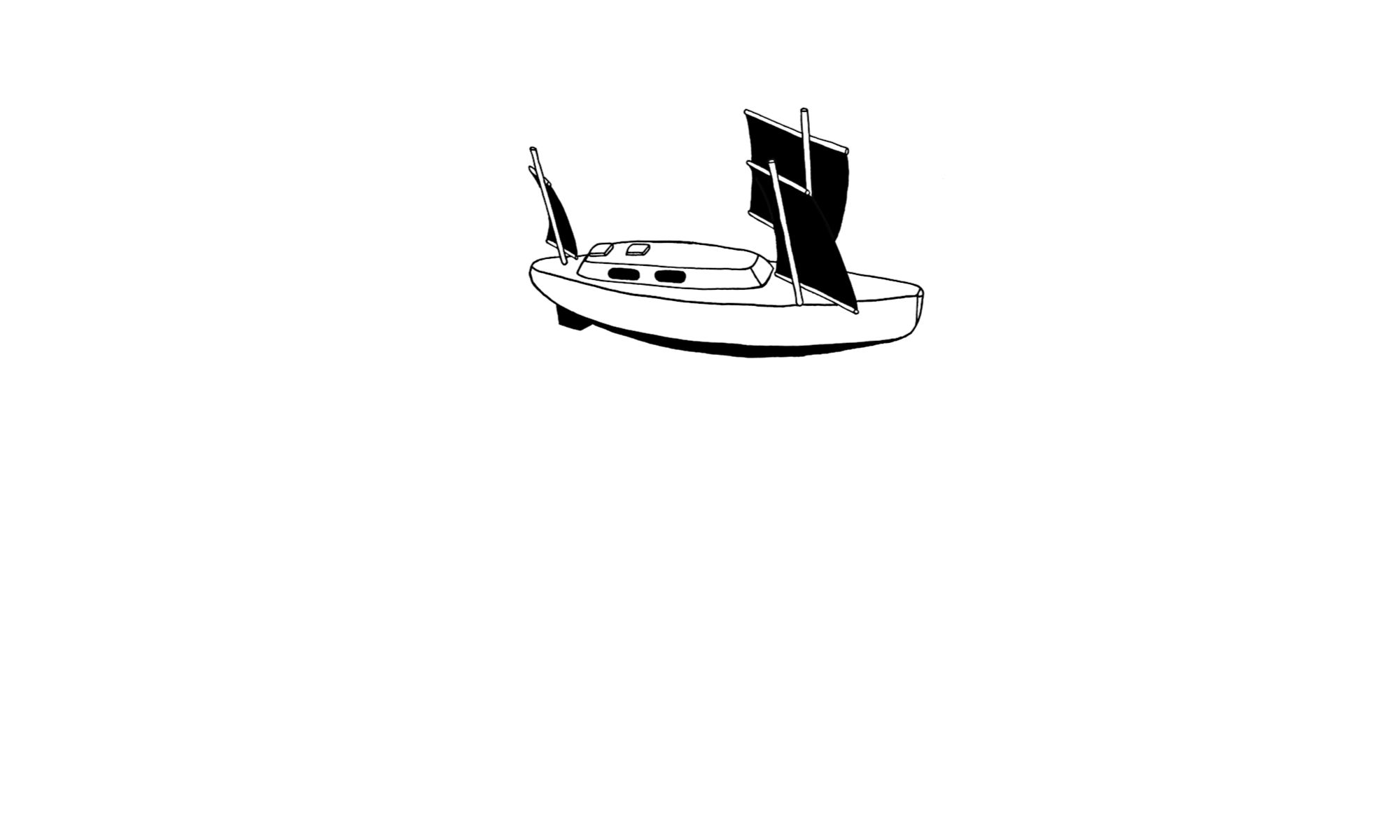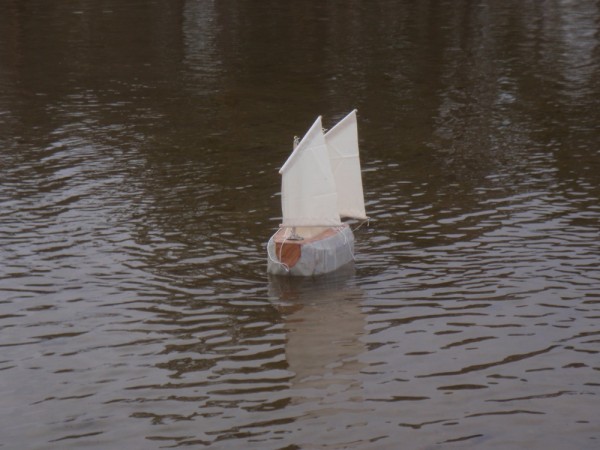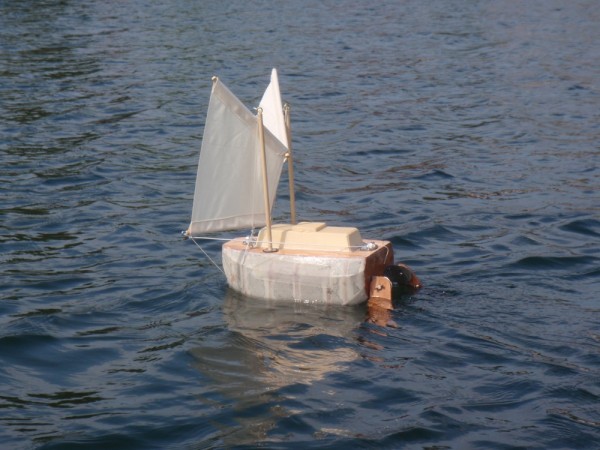Rig choices belong to the domain of aerodynamics, right – wrong. A cruising boat is much more complex than a racer. The more complex a structure is, the more interference there is and nothing is so difficult to deal with as that. But there is also a positive side to complexity and it is that it gives the designer many possibilities to use one element for different purposes.
At first one would not think that the placement of a hatch would influence the choice of rig and normally it does not but when one is designing a ten feet circumnavigator a new set of problems comes up. To deal with storms the interior of my boat is divided into two parts by a watertight traverse bulkhead. The boat has one dry section and one section where saltwater will do no harm. The wet section is in the forward part below the hatch. The two compartments are each about five feet lengthwise. Previous experience has thought me that hatch openings of 40 cm wide and 45 long is convenient. Add 5 cm around for coamings gaskets and labyrinths and the hatch will be 55 cm long – closed. But a hatch that cannot be opened is by definition not a hatch so to make it operational I had to find an unobstructed place for it more than a meter long. That place must be close to the masts, otherwise handling of the sails has to be done from deck and that is not convenient in rough weather. From one hatch it is impossible to reach two masts if they are arranged tandemly. An eight year old girl understands that. That creates a problem. I have solved that problem by arranging the masts side by side and placing the hatch between them. That way I can use one hatch to serve the two masts.
An other advantage – now I can open the hatch because there is no mast in front blocking it – in other words the hatch is in the middle of the boat but the masts are on its side.
Lifeline stanchions are usually 50 – 60 cm high and pretty useless. My center of gravity is 90 cm above the deck. If the lifeline is going to have a chance of doing a good job of keeping me aboard it should be at least one meter high. My masts are strong and high and situated on the boats side they are there in a perfect position to be used as stanchions. This is a good example of how one element can be used for two different purposes. Now I can have lifelines one meter high or more and they will be extremely strongly attached.
Mast placed on small boats centerline blocks the passage for and aft. A pathway in the middle of the boat with high strong lifelines and masts at each side to support you makes moving around safer than the narrow side decks found on a small healing boat.
An other dual use of the side by side masts is that the forward end of the awning can be attached to them. The awning protects against the sun but the main purpose of that piece of canvas is to catch rainwater. A funnel and a hose will conduct it to polyethylene jerry cans. I will be able to store about 70 liters of water, enough for two months.
My side by side pivoting unstayed mast will not use tabernacles. I will put the fulcrum on the chine between deck and sidedeck. That chine is very strong, it only needs to be beefed up locally. The bottom end of the mast will be fixed to a semicircular track on the rub rail. This arrangement is stronger than a tabernacle has less air resistance and its center of gravity is lower. The mast can pivot 20 degrees forward and 20 degrees back. It can also be folded 90 degrees backwards to be stored along the deck in strong winds.
Naturally I will be glad if my novel rig also can propel the boat. A small cruising boat is a complex thing and I may have made mistakes somewhere along my thinking. Although untried I am willing to bet on this side by side rig.
Racing boats are designed with racing rules in mind. Consequently the almost universal custom is to design rigs in such a way that you get maximum effort per sail area. That implies tall rigs with one mast. I see it differently. I am not racing therefore I do not worry about efficiency per square meter sail area. I design for the shortest possible mast. A deep water cruiser have to withstand the seas worsts fury. When it starts to blow a boat with a short mast is much more weatherly than one with a tall mast because the top part of a reefed mast is not only useless it also creates drag, top hamper and slows down the boat. A short mast is not only much stronger than a long one it will also be subject to much less forces. In heavy weather it wins hands down. Out there, far from shelter, the fundamental task is to survive. Nice weather is no problem for me because I like to spend time at sea.
My strategy is to hang on when the wind is contrary and ease the sheets when it starts to come from a more favorable direction. A small boat will not go to windward over ground better than 60 degrees. 60 degrees means twice the distance sailed. Windward sailing also means half the speed. In strong winds the difference between the speeds you make running and beating is even bigger. That means it will take you at least four times as long sailing upwind as downwind. You cannot have a rig that is efficient in both strong and light winds; I have chosen efficiency in strong winds. My weapon: one short mast standing and the other one folded on deck and big, big lateral areas.
The balanced lug sail is very interesting because it is only attached to the mast by its halyard. The mast does not even have a track. By pivoting my mast 20 degrees the masthead mows about three feet for or backward. By moving the downhaul the same distance along the deck the sail can be moved parallel to itself six feet along the deck. That is 60 % of the boats length. That way I can choose weather or lee-helm in any wind strength. Production boats with fixed masts and ballast keels are designed with weather helm. They do not have the option of giving their boat lee helm. Obviously sailing downwind with weather helm is fighting the elements. A seven year old girl can understand that. Trade wind sailing is down wind sailing and on a boat with weather helm the rudder have to be used all the time because the boat is not directional stable on that course.
If I had not had pivoting masts on my side by side rig, then when the apparent wind is on the beam one sail would blanket the other. Now it is easy to separate the sails for maximum wind exposure; I just move the lee sail a bit forward and the windward one a bit back. Problem solved.
In strong winds sailing downwind I will fold the lee mast. I will use the sail on the windward mast. Its center will be close to the center of the boat. Think square sail then move the mast not the sail to windward.
That reduces the rudder force and hence the resistance. If desired I can move the downhaul forward. That will give me a lifting force. Also the windward mast keeps the boom more inboard making it less likely to dip into the waves when the boat is rolling to lee.
However if I would like to ride out a gale slowly forereaching I can use the lee mast because that will give me lots of weather helm for a small sail area. A boat forereaching does not roll much. It also by definition moves slowly so dipping the boom into the water is no worry in that case.
It is much more to write about side by side masts and their interference and integration with a small boat but now I will stop and hopefully come back to the subject at an other time.
You should newer be the first one to try something new, nor should you be the last one to hang on to something old. If you like life tranquille follow that advise but it will not make you into a trailblazer.
The picture below shows the scale 1/8 modell sailing with the mast in tandem position. The aft mast creates unavoidable downwind turbulence.
The picture below shows the modell in light wind with the masts in side by side arrangement. Both mast gets nice clean air.
To be continued…
Regards Yrvind.


